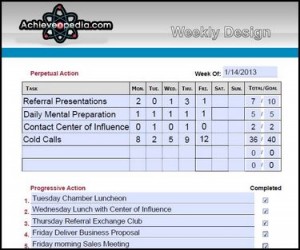Strategize Action Video Overview
Open for: Interactive Workshop
Directing Personal Transformation Video Overview
Measure Achievements
The operating objectives are:
- Measure Achievements
- Make Adjustments
- Maintain Advancements
- Multiply Accomplishments
Members are now empowered with the ability to evaluate progress, analyze needs and to master problem-solving… as they journey forward personally and professionally!
Measured Achievements

Positioning the Tactical Productivity Process…
Above is an example of our Weekly Design worksheet. It contains Perpetual Action Cycles and a Progressive Action Checklist. They are the strategic options you have chosen for your action plan for the week.
In Atomic Productivity these are part of the “PAC for Success” system located within the Idea Banks of our Success Communities.
- The “Perpetual Action Cycles” are repeated weekly and are the fundamentals that become habits.
- The “Progressive Action Checklist” are single action steps; one and done to do tasks for the week.
Find yourself a few good Power Partners and together process each week’s activities. Power Partners provide a tremendous support for maintaining progress, staying focused, enhancing creativity and elevating commitments.
Tactical Productivity questions that evaluate progress
- What results were achieved? Where did you succeed or fall short?
- What progress was made? What was learned and experienced?
- What action is working? Capture what worked in your Idea Bank…duplicate that action!
- Are there missed assignments that you need to address? Skills to be sharpened?
- What are the possible obstacles to completing those assignments?
Obstacles to Execution
Below are the most common obstacles to our effectiveness.
Change of Priorities – Unexpected events that change your previously established commitments.
False Priorities – The personal goals and objectives you have chosen are not really as important as initially believed.
Training Needs – Uncertain or unaware of improved actions needed to execute your objectives.
Procrastination – The pit where opportunity is buried.
Blind Spots – Not being aware of additional opportunities that may have been available at the time.
Stuck Behavior Patterns – More motivated by the comfort of familiar routines then the desire to improve results.
Temperament Challenges – Your natural personality tendencies are in contradiction to the consistent behaviors required to keep progress on track.
Low Adversity IQ – Difficult or challenging situations created paralyzing stress rather than greater commitments.
Not Organized Effectively – Slowed down by disorder and bottle-necks of information.
Possible Conflict of Values – Action steps may have conflicted with your own personal values or standards of behavior.
Failing in Time Management – Spending a disproportionate amount of time in low pay-off activities. Often an avoidance mechanism and a form of procrastination.
Minimum Requirement Comfort Zones – The minimum you must do has become the maximum you are willing to do. This is the most common reason for mediocrity.
Attitude Conflicts or Contradicting Perspectives– Have not mentally or emotionally accepted or embraced the action you need to take.
Fear of Failure – Lacking the courage to take action for fear of loss, making mistakes or experiencing rejection.
Lack of Accountability – No accountability to your weekly intentions and commitments. Yielding to weak excuses for your lack of effectiveness.
Lack of Commitment – Unwilling or lacking the discipline to do what you need to do to take care of business!
Options for Inspired Collaboration
Extensive Training Library
The Keys to Multiplying Accomplishments
The most dynamic way to achieve our goals is to solve any problems between where we are now and the destination of our journey. Start by believing that no problem can withstand the assault of sustained thinking!
Every obstacle and problem is a gift; you receive its rewards by resolving the situation that is standing in your way. This strengthens your effectiveness, builds your confidence and multiplies opportunities!
Mastering problem solving is an art. A teachable and transferable art. It just takes courage, imagination and the tenacity to stick with it; but anyone can do it.
For a quick analogy…If a teacher gives us the same test every Friday and handed us the results the following Monday, we would improve our score if we continued to study those answers we got wrong. Taking weekly inventory of obstacles and recommitting to finding answers results in continuous improvement within ourselves and our effectiveness. It’s a no brainer that our score and results will improve.
Every problem we solve promotes us to the next level. The object of the game is to progressively improve our score until we reach the success we are looking to achieve. Every time our score improves it reduces our Power Gap bringing us closer to our destination and we become more Empowered to Succeed.